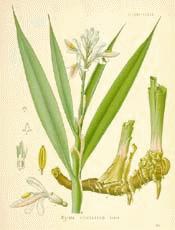

|
Galangal
(Alpinia officinarum Hance)
|
Galangal
Botanical: Alpinia officinarum (HANCE.)
Family: N.O. Zingaberaceae or Scilaminae
---Synonyms---Galanga. China Root. India Root. East India Catarrh Root. Lesser Galangal. Rhizoma Galangae. Gargaut. Colic Root. Kaempferia Galanga.
---Part Used---Dried rhizome.
---Habitat---China (Hainan Island), Java.
---Description---The genus Alpinia was named by Plumier after Prospero Alpino, a famous Italian botanist of the early seventeenth century. The name Galangal is derived from theArabic Khalanjan, perhaps a perversion of a Chinese word meaning 'mild ginger.'
The drug has been known in Europe for seven centuries longer than its botanical origin, for it was only recognized in 1870, when specimens were examined that had been found near Tung-sai, in the extreme south of China, and later, on the island of Hainan, just opposite. The name of Alpinia officinarum was given to the herb, as the source of Lesser Galangal. The Greater Galangal is a native of Java (A. Galanga or Maranta Galanga), and is much larger, of an orange-brown colour, with a feebler taste and odour. It is occasionally seen at London drug sales, but is scarcely ever used. There is also a resemblance to A. calcarata.The herb grows to a height of about 5 feet, the leaves being long, rather narrow blades, and the flowers, of curious formation, growing in a simple, terminal spike, the petals white, with deep-red veining distinguishing the lippetal.
The branched pieces of rhizome are from 1 1/2 to 3 inches in length, and seldom more than 3/4 inch thick. They are cut while fresh, and the pieces are usually cylindrical, marked at short intervals by narrow, whitish, somewhat raised rings, which are the scars left by former leaves. They are dark reddish-brown externally, and the section shows a dark centre surrounded by a wider, paler layer which becomes darker in drying. Their odour is aromatic, and their taste pungent and spicy. They are tough and difficult to break, the fracture being granular, with small, ligneous fibres interspersed throughout one side. The drug is exported, chiefly from Shanghai, in bales made of split cane, plaited, and bound round with cane. The root has been used in Europe as a spice for over a thousand years, having probably been introduced by Arabian or Greek physicians, but it has now largely gone out of use except in Russia and India. Closely resembling ginger, it is used in Russia for flavouring vinegar and the liqueur 'nastoika': it is a favourite spice and medicine in Lithuania and Esthonia. Tartars prepare a kind of tea that contains it, and it is used by brewers. The reddishbrown powder is used as snuff, and in India the oil is valued in perfumery.
---Constituents---The root contains a volatile oil, resin, galangol, kaempferid, galangin and alpinin, starch, etc. The active principles are the volatile oil and acrid resin. Galangin is dioxyflavanol, and has been obtained synthetically. Alcohol freely extracts all the properties, and for the fluid extract there should be no admixture of water or glycerin.
---Medicinal Action and Uses---Stimulant and carminative. It is especially useful in flatulence, dyspepsia, vomiting and sickness at stomach, being recommended as a remedy for sea-sickness. It tones up the tissues and is sometimes prescribed in fever. Homoeopaths use it as a stimulant. Galangal is used in cattle medicine, and the Arabs use it to make their horses fiery. It is included in several compound preparations, but is not now often employed alone.
The powder is used as a snuff for catarrh.
---Dosage---From 15 to 30 grains in substance, and double in infusion. Fluid extract, 30 to 60 minims.
[Top]
Common Name Index
A MODERN HERBAL Home Page
Bear in mind "A Modern Herbal" was written with the conventional wisdom of the early 1900's. This should be taken into account as some of the information may now be considered inaccurate, or not in accordance with modern medicine.
© Copyright Protected 1995-2004 botanical.com

|

